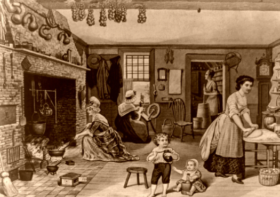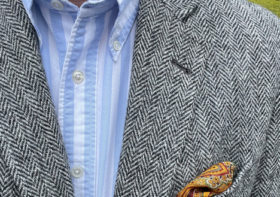Footwear For City-Dwellers

Most of us fall into either the “city mouse” or “country mouse” designations. We either prefer bustling urban centers, or peaceful rural locales.
Personally, I prefer to live in a rural area and visit cities as opposed to the other way around.
Growing up, I lived in the suburbs. I moved to New York City after college and realized, after some time, that I was not destined to live in a city full-time, especially after getting married and having kids.
I’m in the city every so often for work (the work that actually pays me) and I enjoy the stark difference from where I currently live, which is very rural. Because of this dichotomy, I’ve realized that the sartorial needs of the city mouse differ somewhat from those of the country mouse.
I’m well aware that this is hardly rocket science. Things like tweed jackets and brogue shoes originated from the specific needs of the rural gentleman. But those old maxims like “no brown in town” don’t really apply anymore. These days, the lines of dress codes between town and country are fuzzy, at best.
Given this fact, you might think that your clothing choices don’t really need to differ much if you’re either in the city or country. I used to think that was true. But then I started thinking about how I would dress if I moved back to the city. After all, I didn’t really start my grand sartorial journey until I moved out of the city (partly because when I was living in the city I didn’t have the money to buy anything).
So, let’s take one clothing category (footwear) and examine what details you should look for if you are indeed a city-dweller.
The most important criterion for city footwear is support. If you live in a big city, you probably walk a lot. That’s certainly true for New York City, but even in places like Los Angeles, even if you aren’t walking much, you’re still on hard pavement when you’re on your feet.
For this reason, I find that popular choices like heritage-style boots or boat shoes aren’t all that great for city living since they don’t provide much support.
When I lived in the city, I frequently wore a pair of Red Wing Iron Rangers. Sure, they looked great, but they were murder on my lower body. As you probably know, many well-made boots come with a hard leather footbed, and while authentic to vintage styles, they’re going to be tough to walk in for more than a few blocks. Your feet and knees are going to ache like crazy. At least mine did.
Due to the lack of support I also became keenly aware of the slant of the sidewalk depending on which side of the street I was walking on. Since the sidewalk is tilted ever so slightly toward the street, I found that I needed to alternate which side I walked on so that my feet and knees wouldn’t get sore. Isn’t that crazy? I’m not saying it will definitely happen to you, but I’m just relaying my experience.
So, making sure your choice of footwear has adequate support is priority number one. What else?
Well, your footwear is going to need to be robust, so go with a brand that has a reputation for quality. This doesn’t mean it has to be expensive. When I lived in Dublin, Ireland, I wore a pair of Dr. Martens. They weren’t the big boots that everyone thinks of when they hear “Docs”. They were casual leather derby style shoes with a thick squishy sole (I think to protect the wearer from electrocution or something silly like that). Even though I only paid probably $100 for them, they served me well given all the walking I did. Conversely, when my wife and I visited Dublin many years later, I wore through a pair of much lower-quality shoes in a week.
City living requires a little resilience and your footwear needs to reflect that. You’re going to be bashing your feet against curbs and subway stairs. You’re going to put a lot of mileage on the odometer.
Two other details that often get overlooked when someone is looking for city footwear are waterproofness and traction. Let’s tackle waterproofness first.
You may think that it’s mostly people in the country who need to worry about having water-resistant shoes or boots, but it’s arguably more important in the city. The reason is because people in the country are never too far away from their automobiles, homes, or places of work. Unless they are doing yard work, or hiking, or something specifically outside, there usually isn’t an urgent need for waterproofness. Yes, I like having waterproof boots when I dash to my truck during a storm, but people who live in the country don’t usually step outside in the morning with just a bag and the clothes on their back and not return until evening.
Unless they mean to, country folk aren’t outside for an unexpected, extended period of time.
Now, contrast with the city dweller who’s on the subway and realizes their train isn’t making its regular stops. Now they have to dash twenty extra blocks in the rain.
Or, how about during particularly slushy times of year when the water and ice pool at the corners of the streets and it looks like solid ground until you step on it and get submerged up to your shins?
If you’re in the city, you don’t want to run the risk of getting your feet soaked at 8:30am and not be able to change your shoes until 8:30pm. So while it’s not imperative that your footwear be completely waterproof, you do need at least a sufficient level of water-resistance.
Now, let’s talk traction. Most of the time, in the city, you’re going to be on flat pavement, so you won’t need as much grip as if you were hiking in the country. Sure, there may be some snow if you live in the north, but you likely aren’t going to encounter much mud or wet leaves or things like that. That all means that you are not going to need an aggressive tread on your footwear like a big commando sole. Also, those big lug soles sometime slip MORE when you’re on a slick surface like a wet office floor.
That’s not to say that you don’t need any traction. You absolutely do. I fell numerous times in my Iron Rangers because they had a smooth sole with zero grip.
Your best bet when it comes to traction in the city is a simple rubber sole or a subtle lug. Leather soles, like on most dress shoes will be ok most of the time, since they get roughed up after a while, but if you’re looking for the best all-around option, you’re better off choosing something with a bit more bite.
Last but not least, your choice of city footwear should be versatile.
On any given day, you might be stopping by your business-casual office, then meeting a friend for lunch, then grabbing drinks at an upscale bar after work, then sitting on a blanket in the park to watch a movie. Or how about taking the kids to the playground, or hitting up a museum, or going to a nice restaurant with your wife.
As I stated earlier, when you live in the city, you don’t usually pop in and out of your apartment throughout the day. Once you’re out, you’re out for the day, so your footwear needs to be able to pull double and triple duty depending on what you have planned.
That means your footwear shouldn’t lean too far into any one category, be it casual or formal. A super clunky, utilitarian boot might look cool on Instagram, but you don’t want to be bashing it against every chair and table leg in the restaurant. Likewise, sleek, polished dress shoes are going to look a little dandy-ish when you’re at the beer garden on a hot, summer day.
One last word on versatility. Make sure you can wear your shoes or boots all year round. Anyone who has ever lived in the city knows that space is very hard to come by. You don’t want to eat up that space with multiple pairs of shoes you can only wear part of the year.
Now that I have given you some guidelines on how to choose your city footwear, I’ll leave you with a few suggestions to help you get started…
Beckett Simonon Dunham Derbies – These are my go-to city shoe. I did a review of them a while back.

Alden Indy Boots or brogue boots.


Nisolo Chukkas – I owned a pair of these for a long time until I wore them out. Very comfortable and durable.




